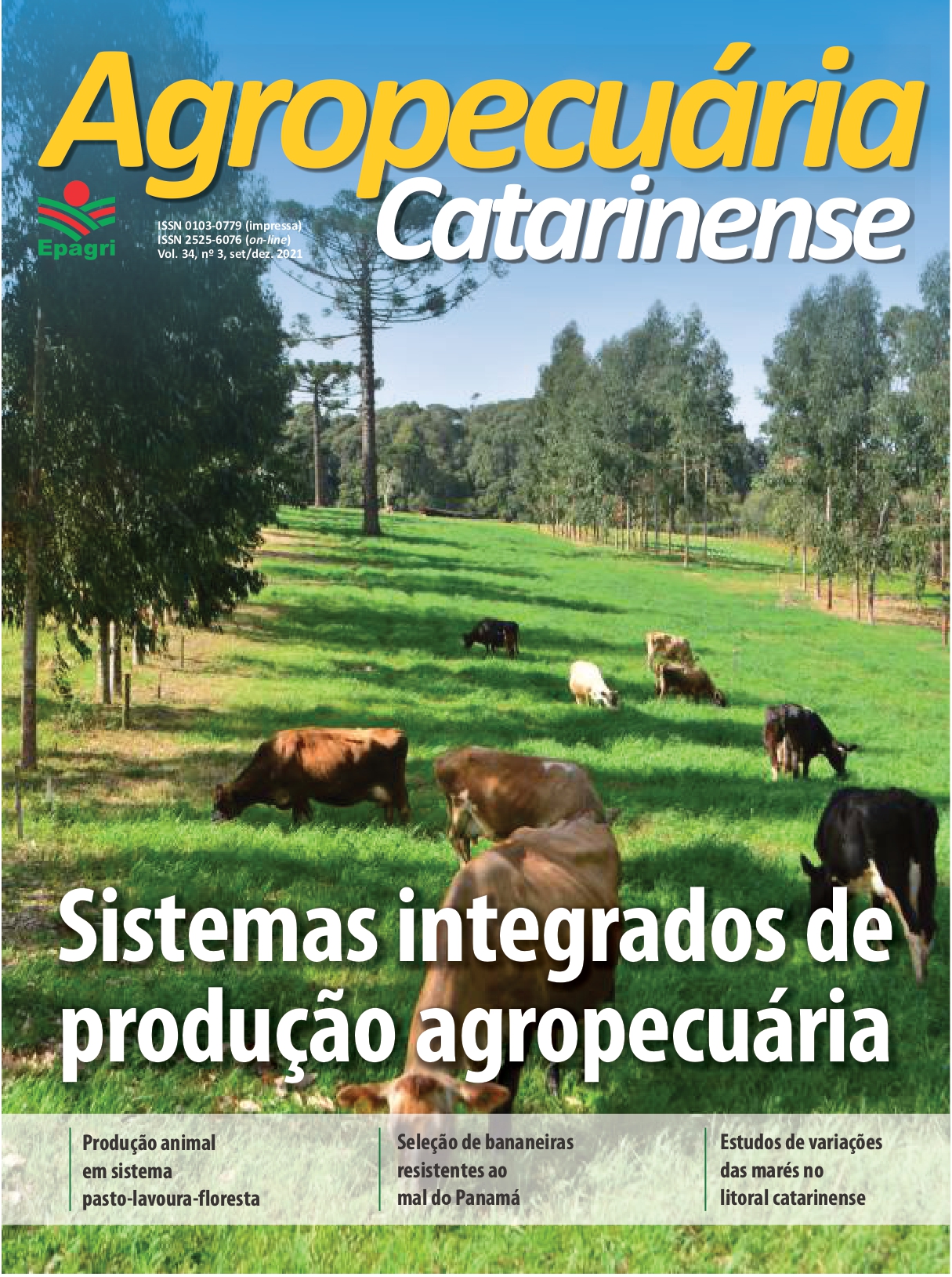Compositi on of weeds in diff erent integrated crop-livestock system
DOI:
https://doi.org/10.52945/rac.v34i3.1274Keywords:
herbology, weed, botanalAbstract
Globally, the potenti al of integrated systems is recognized as a sustainable way to feed nine billion people in 2050. These systems can increase environmental resilience by increasing biological diversity and by the effective and efficient cycling of nutrients, which entails improving soil quality, in addition to providing ecosystem services and contributi ng to climate change adaptation and mitigation. The objective of this work was to evaluate the occurrence and species composition of weed in the corn crop in the Integrated Crop-Livestock System (ICLS). The experimental design was randomized blocks, with 4 treatments and 3 repetitions. The variety of “BRS Sol da Manhã” corn was cultivated in four systems: crop (C), integrated with crop-livestock (CP), crops-forest (CF) and crops-livestock-forest (CLF), all without the use of herbicide. The occurrence and composition of weeds in the different production systems was evaluated through a survey of the botanical composition in dry matter (kg ha-1). There was a large contribution of Megathyrsus maximus cv. Áries in all systems, mainly in the CLF, as well as a predominance of Urochloa brizantha in the CL, in addition to the of very high contribution Hemarthria altíssima in the CF system. The ICLS produced 5.8t ha-1 corn without the use of herbicides.Metrics
Publication Facts
Reviewer profiles N/A
Author statements
- Academic society
- Epagri - Revista Agropecuária Catarinense
- Publisher
- Empresa de Pesquisa Agropecuária e Extensão Rural de Santa Catarina - Epagri
References
CARVALHO, P. C. D. F., MORAES, A. D., PONTES, L. D. S., ANGHINONI, I., SULC, R. M., BATELLO, C. Definições e terminologias para sistema integrado de produção agropecuária. Revista Ciência Agronômica, v.45, p.1040-1046, 2014. DOI: https://doi.org/10.1590/S1806-66902014000500020.
CONAB. Acompanhamento da Safra Brasileira. Séries históricas. Disponível em: https://www.conab.gov.br/info-agro/safras/serie-historica-das-safras. Acesso em: 10 outubro 2021.
COSER, A.C.; NASCIMENTO JUNIOR, D.; GOMIDE, J. A.; SILVA, J. F. C.; SILVA, M. A. GARCIA, R.; MARTINS, C. E. Utilização do Botanal em comparação a outros métodos de avaliação. Pesquisa Agropecuária Brasileira. Brasília, p.759-767, 1991.
DOMINSCHEK R., BARROSO A. A. M., LANG C. R., DE MORAES A., SULC R. M., SCHUSTER M. Z. Crop rotations with temporary grassland shifts weed patterns and allows herbicide-free management without crop yield loss. Journal of Cleaner Production, v.306, 2021, DOI: https://doi.org/10.1016/j.jclepro.2021.127140.
DOMINSCHEK, R.; KRUCHELSKI, S.; DEISS, L.; PORTUGAL, T.B.; DENARDIN, L.G.; MARTINS, A.P.; LANG, C.R.; DE MORAES, A. Sistemas integrados de produção agropecuária na promoção da intensificação sustentável: Boletim Técnico do NITA [recurso eletrônico]. Curitiba. Universidade Federal do Paraná, Departamento de Fitotecnia e Fitossanitarismo, 2018.
EMBRAPA. Resistência de plantas daninhas a herbicidas: conceitos, origem e evolução. Passo Fundo: Embrapa Trigo, 2006. 22p. ISSN: 1518-6512. Publicação Online. Disponível em: http://ainfo.cnptia.embrapa.br/digital/bitstream/CNPT-2010/40676/1/p-do58.pdf. Acesso em: 25 julho 2021.
EMBRAPA. Sistema Brasileiro de Classificação de Solos. 5. ed., rev. e ampl. Brasília, DF: Embrapa, 2018. 356 p.
HARGREAVES, J.; KERR, J. BOTANAL - A comprehensive sampling and computing procedure for estimating pasture yield and composition. Computational package. St Lucia, Qld.: CSIRO Division of Tropical Crops and Pastures,1992.
IDR-PARANÁ. Instituto de Desenvolvimento Rural do Paraná – IAPAR-EMATER. Atlas Climático do Estado do Paraná [recurso eletrônico]. Londrina (PR): Instituto Agronômico do Paraná, 2019. 210p. Disponível em: http://www.idrparana.pr.gov.br/system/files/publico/agrometeorologia/atlas-climatico/atlas-climatico-do-parana-2019.pdf. Acesso em: 03 abril 2021.
LEVINSKI-HUF, F. Adubação de sistemas e comportamento dos nutrientes em sistema de integração lavoura-pecuária. Tese (Doutorado), Universidade Tecnológica Federal do Paraná. Programa de Pós-Graduação em Agronomia. Pato Branco, PR. 2018.
PIASSETTA, R. R. L.; SOUZA, N.J.; MIKOS, A.P.; AUER, C.G. Legislação restritiva referente ao uso de agrotóxicos em municípios do Estado do Paraná. BIOFIX Scientific Journal, v.6, n.1, p.75-83, 2021. DOI: https://doi.org/10.5380/biofix.v6i1.77378.
PITELLI, R.A. Planta Daninha, Viçosa-MG, v.33, n.3, 2015. DOI: https://doi.org/10.1590/S0100-83582015000300025.
RODRIGUES, V.N.; VON PINHO, R.G.; PAGLIS, C.M.; BUENO FILHO, J.S.S.; BRITO, A. H. Comparação entre métodos para estimar a produtividade de grãos de milho. Ciência e Agrotecnologia, v.29, n.1, p.34-42, 2005. DOI: https://doi.org/10.1590/S1413-70542005000100004
SCHUSTER, M.Z, PELISSARI, A.; DE MORAES, A.; HARRISON, S.K.; SULC, R.M.; LUSTOSA, S.B.C.; ANGHINONI, I.; CARVALHO, P.C.F. Grazing intensities affect weed seedling emergence and the seed bank in an integrated crop–livestock system. Agriculture, Ecosystems & Environment, v.232, 2016, p.232-239. DOI: https://doi.org/10.1016/j.agee.2016.08.005.
SCHUSTER, M.Z.; LUSTOSA, S.B.C.; PELISSARI, A.; HARRISON, S.K.; SULC, R. M.; DEISS, L.; LANG, C.R.; CARVALHO, P.C.D.F.; GAZZIERO, D.L.P.; MORAES, A. Optimizing forage allowance for productivity and weed management in integrated crop-livestock systems. Agronomy for sustainable development, v.39, n.2, p.1-10, 2019. DOI: https://doi.org/10.1007/s13593-019-0564-4.
WEISBERGER D., NICHOLS V., LIEBMAN M. Does diversifying crop rotations suppress weeds? A meta-analysis. PloS ONE, v.14, n.7, p.e0219847, 2019. DOI: https://doi.org/10.1371/journal.pone.0219847
Downloads
Published
How to Cite
Issue
Section
License
Copyright (c) 2021 Daniel de Queiroz Barbosa; João Pedro Tavares Fernandes, Camila Crestani, Leandro Bittencourt Oliveira, Anibal Moraes, Claudete Reisdorfer Lang

This work is licensed under a Creative Commons Attribution 4.0 International License.





